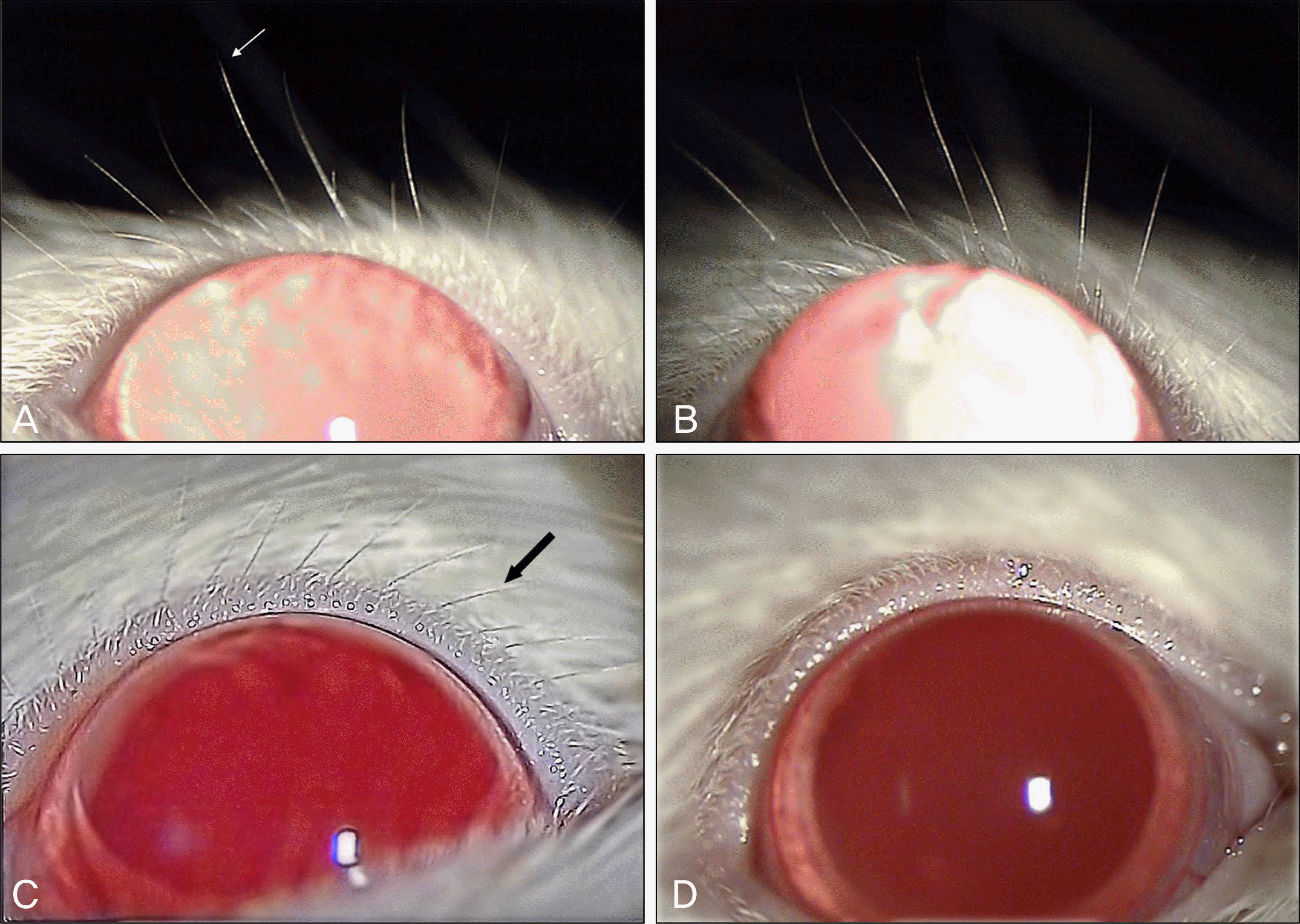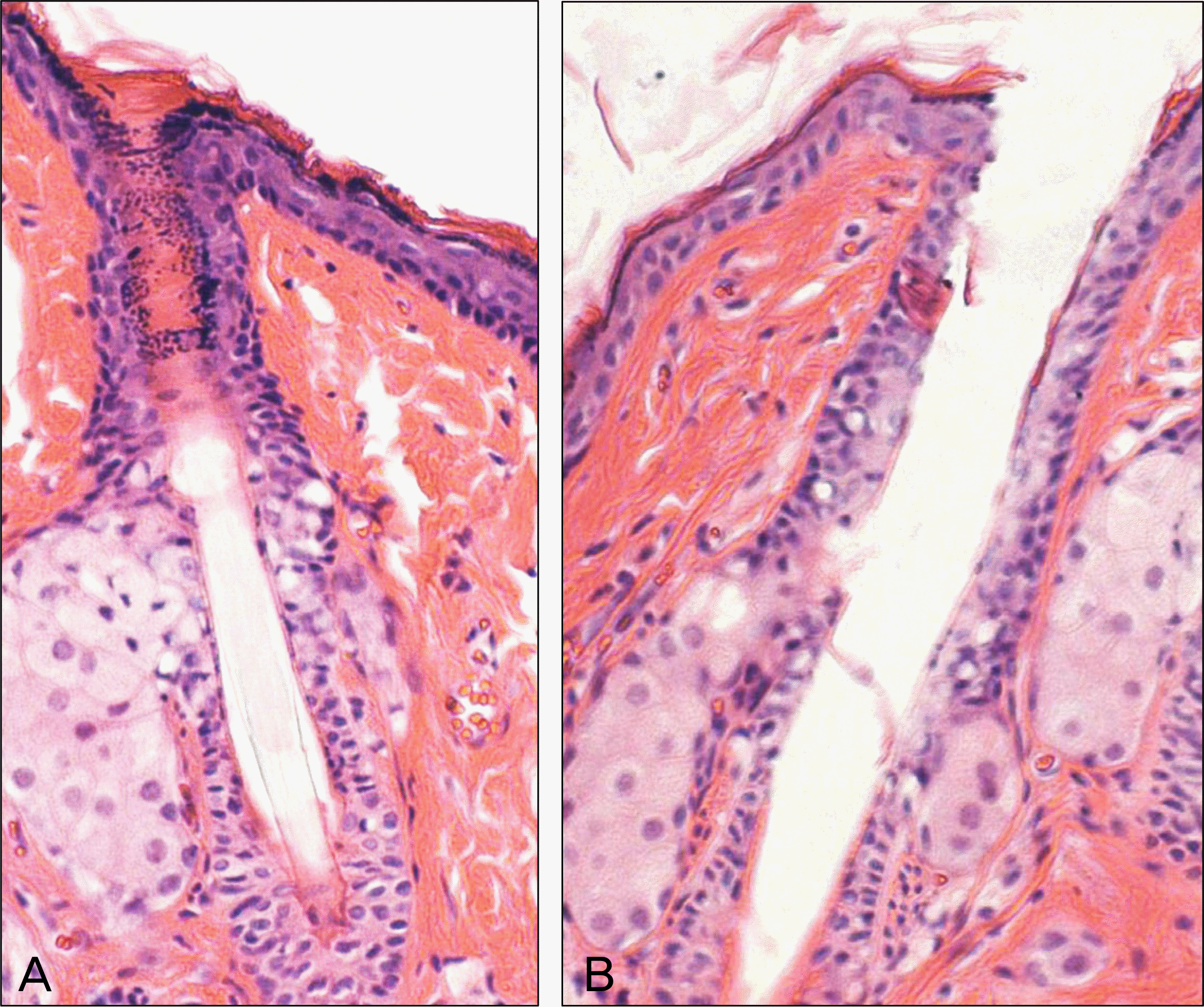Abstract
Purpose
The aim of the present study was to determine the effects of mitomycin C (MMC) on eyelash regrowth in rats.
Methods
Ten rats were subjected to bilateral eyelid epilation. One drop of 0.04% MMC solution and one drop of normal saline was then administered to the right and left eyelid, respectively. Three months post-epliation, the number of regrown eyelashes was counted, and a section of tissue from each eyelid was examined under light- and electron microscopies.
Results
The number of regrown long eyelashes was 1.0 ± 0.81 on the right, and 12.5 ± 1.08 on the left. The rate of regrowth was 7.35 ± 5.55% on the right and 98.45 ± 3.27% on the left. Histological examination revealed no significant differences between the right and left eyelids, except for the absence of any hair shafts in the follicles on the right. However, electron microscopy revealed mitochondrial damage in the follicles of the right eyelid. These changes were not observed in tissue from the left eyelid.
References
1. Yeung YM, Hon CY, Ho CK. A simple surgical treatment for upper lid trichiasis. Ophthalmic Surg Lasers. 1997; 28:74–6.

2. Russell HC, Chadha V, Lockington D, Kemp EG. Topical mitomycin C chemotherapy in the management of ocular surface neoplasia: a 10-year review of treatment outcomes and complications. Br J Ophthalmol. 2010; 94:1316–21.

3. Thylefors B, Négrel AD, Pararajasegaram R, Dadzie KY. Global data on blindness. Bull World Health Organ. 1995; 73:115–21.
5. West ES, Munoz B, Imeru A, et al. The association between epilation and corneal opacity among eyes with trachomatous trichiasis. Br J Ophthalmol. 2006; 90:171–4.

6. Chiou AG, Florakis GJ, Kazim M. Management of conjunctival cicatrizing diseases and severe ocular surface dysfunction. Surv Ophthalmol. 1998; 43:19–46.

7. Hecht SD. Cryotherapy of trichiasis with use of the retinal cryoprobe. Ann Ophthalmol. 1977; 9:1501–3.
8. Campbell DC. Thermoablation treatment for trichiasis using the argon laser. Aust N Z J Ophthalmol. 1990; 18:427–30.

9. Elder MJ, Bernauer W. Cryotherapy for trichiasis in ocular cicatri-cial pemphigoid. Br J Ophthalmol. 1994; 78:769–71.

10. Johnson RL, Collin JR. Treatment of trichiasis with a lid cryoprobe. Br J Ophthalmol. 1985; 69:267–70.

11. Sullivan JH, Beard C, Bullock JD. Cryosurgery for treatment of trichiasis. Am J Ophthalmol. 1976; 74:189–202.

12. Sullivan JH. The use of cryotherapy for trichiasis. Trans Sect Ophthalmol Am Acad Ophthalmol Otolaryngol. 1977; 83:708–12.
14. Elder MJ, Bernauer W. Cryotherapy for trichiasis in ocular cicatri-cial pemphigoid. Br J Ophthalmol. 1994; 78:769–71.

15. Gossman MD, Yung R, Berlin AJ, Brightwell JR. Prospective evaluation of the argon laser in the treatment of trichiasis. Ophthalmic Surg. 1992; 23:183–7.

16. Sharif KW, Arafat AF, Wykes WC. The treatment of recurrent trichiasis with argon laser photocoagulation. Eye. 1991; 5:591–5.

18. Oguz H, Aras C, Ozdamar A. Thermoablation treatment for trichiasis in trachoma using the semiconductor diode pumped laser. Eur J Ophthalmol. 1999; 9:85–8.

19. Ladas ID, Karamaounas N, Vergados J, et al. Use of argon laser photocoagulation in the treatment of recurrent trichiasis: long-term results. Ophthalmologica. 1993; 207:90–3.

20. Sharif KW, Arafat AF, Wykes WC. The treatment of recurrent trichiasis with argon laser photocoagulation. Eye (Lond). 1991; 5:591–5.

21. Yung CW, Massicotte SJ, Kuwabara T. Argon laser treatment of tri-chicasis: a clinical and histopathologic evaluation. Ophthal Plast Reconstr Surg. 1994; 10:130–6.
22. Bi YL, Zhou Q, Xu W, Rong A. Anterior lamellar repositioning with complete lid split: a modified method for treating upper eyelids trichiasis in Asian patients. J Plast Reconstr Aesthet Surg. 2009; 62:1395–402.

23. Hintschich CR. “Anterior lamellar repositioning” for correction of entropion of the upper eyelid. Ophthalmologe. 1997; 94:436–40.
25. Burton M, Solomon A. What's new in trichiasis surgery? Community Eye Health. 2004; 17:52–3.
26. Khandakar R, Al-Hadrami K, Sarvanan N, et al. Recurrence of trachomatous trichiasis 17 years after bilamellar tarsal rotation procedure. Am J Ophthalmol. 2006; 141:1087–91.
27. Thanh TT, Khandekar R, Luong VQ, Courtright P. One year recurrence of trachomatous trichiasis in routinely operated Cuenod Nataf procedure cases in Vietnam. Br J Ophthalmol. 2004; 88:1114–8.

28. Khandekar R, Mohammed AJ, Courtright P. Recurrence of trichiasis: a long-term followup study in the Sultanate of Oman. Ophthalmic Epidemiol. 2001; 8:155–61.

29. Bowman RJ, Faal H, Jatta B, et al. Longitudinal study of trachomatous trichiasis in The Gambia: barriers to acceptance of surgery. Invest Ophthalmol Vis Sci. 2002; 43:936–40.
30. Kunitomo N, Mori S. Studies on the pterygium. Part 4. A treatment of the pterygium by mitomycin-C instillation. Acta Soc Ophthalmol Jpn. 1963; 67:601.
31. Palmer SS. Mitomycin as adjunct chemotherapy with trabeculectomy. Ophthalmology. 1991; 98:317–21.

32. Frucht-Pery J, Rozenman Y. Mitomycin C therapy for corneal in-traepithelial neoplasia. Am J Ophthalmol. 1994; 117:164–8.

33. Russell HC, Chadha V, Lockington D, Kemp EG. Topical mitomycin C chemotherapy in the management of ocular surface neoplasia: a 10-year review of treatment outcomes and complications. Br J Ophthalmol. 2010; 94:1316–21.

34. Kao SC, Liao CL, Tseng JH, et al. Dacryocystorhinostomy with intraoperative mitomycin C. Ophthalmology. 1997; 104:86–91.

35. You YA, Fang CT. Intraoperative mitomycin C in dacryocystorhinostomy. Ophthal Plast Reconstr Surg. 2001; 17:115–9.

36. Lee DH, Chung HS, Jeon YC, et al. Photorefractive keratectomy with intraoperative mitomycin-C application. J Cataract Refract Surg. 2005; 31:2293–8.

37. Khong JJ, Muecke J. Complications of mitomycin C therapy in 100 eyes with ocular surface neoplasia. Br J Ophthalmol. 2006; 90:819–22.

38. Singh G, Wilson MR, Foster CS. Long-term followup study of mitomycin eye drops as adjunctive treatment of pterygia and its comparison with conjunctival autograft transplantation. Cornea. 1990; 9:331–4.
39. Bindlish R, Condon GP, Schlosser JD, et al. Efficacy and safety of mitomycin-C in primary trabeculectomy: five-year followup. Ophthalmology. 2002; 109:1336–41. discussion. 1341–2.
Figure 1.
Photographs of the eyes of an experimental rat. Long eyelashes of the left (A, B) & right (C, D) upper eyelids.(A) Prior to epilation. (B) 3 months post-epilation and administration of normal saline (eyelash-regrowth was observed). (C) Prior to epilation. (D) 3 months post-epilation and administration of 0.04% mitomycin C solution (eyelash-regrowth was not observed).

Figure 2.
Light microscopy images of vertical section of excised rat eyelid tissue. The number and size of the hair follicle cells was normal in both the right and left eyelids. However, no hair shaft is present in the hair follicle on the right (treated with mitomycin C) (Hematoxylin-eosin, ×200). (A) Hair follicle of the left eyelid: 3 months post-epilation and administration of normal saline. (B) Hair follicle of the right eyelid: 3 months post-epilation and administration of 0.04% MMC solution.

Figure 3.
Electron micrographs of the eyelid from rats. (A) Normal mitochondria are visible in the hair follicle of the left eyelid (saline-instilled). (B) Mitochondrial destruction is visible in the hair follicle of the right eyelid (mitomycin C-in-stilled). ∗ Mitochondria.

Table 1.
Number of long eyelashes on the upper eyelid




 PDF
PDF ePub
ePub Citation
Citation Print
Print


 XML Download
XML Download